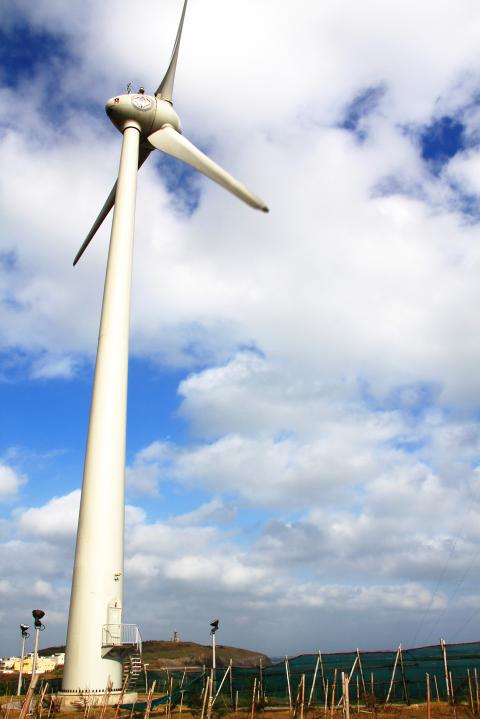While strong winds may be a bane for tourism in Penghu during winter, they may yet prove to be an economic boon once the 45m tall wind power turbines and submarine power cables are all installed by 2016, which could generate as much as NT$13 billion (US$434 million) a year in electricity, academics estimate.
At present, giant wind turbines spin at two sites on the island — near the coasts of Baisha Township’s (白沙) Jhongtun Village (中屯) and Husi Township’s (湖西) Peiliao Village (北寮). Both wind power sites are operated by state-owned Taiwan Power Co (Taipower).
Penghu’s power consumption is about 40,000 watts, Chien Shan Power Station deputy director Ou Chih-cheng (歐致誠) said, adding that the two power stations could already generate 10,000 watts, accounting for about one-fourth of the island’s energy demand.

Photo: Lee I-chia, Taipei Times
“During winter, wind speeds can sometimes get up to 20m/s [meters per second]. Since a wind velocity of 13m/s or 14m/s is enough for the generated power to reach full load, there are more than 150 days in a year in which the power generated by turbines reaches full load,” he said, adding that the full load rate was about 43 percent.
Ou said that the electricity generated from the two stations in 2010 added up to about 11 percent of the island’s total electricity supply. Not only do the turbines reduce the cost of power-generation, they also contribute to carbon reduction, which is in line with the government’s aim of turning Penghu into a world-class low-carbon island.
Yeh Kuo-ching (葉國清), director-general of the county’s Economic Affairs Bureau, said that once the construction of a submarine power cable between Taiwan proper and Penghu is completed in 2016, more wind turbines will be installed on the island and the surplus electricity generated will be sold back to Taiwan proper.
Aside from the spinning wind turbines operated by Taipower, state-of-the-art wind turbine technology experiments are also taking place on the island.
In 2007, National Penghu University of Science and Technology began a project commissioned and funded by the National Science Council to establish a 5,000m2 Wind Park at its campus for educational and research purposes.
The park is free for companies that want to test their wind turbines. It now hosts 47 small, experimental wind turbines installed by 20 companies worldwide. All the turbines have their own monitoring systems, which record their condition and efficacy and are transmitted by Internet for analysis and further improvement.
The university’s former president, Lin Huei-jeng (林輝政), now a professor at National Taiwan University’s Department of Engineering Science and Ocean Engineering and who led the program, said that based on data from 2008, “the average wind speed in Penghu was 9.75m/s and the wind gets stronger during winter months, increasing to about 16m/s, which is nearly the wind speed of a mild typhoon [17.2m/s to 32.6m/s].”
He said the strong winds on Penghu can put the companies’ newest designs to the test.
“Some companies were very confident about the [quality] of their turbines when they were installing them in the park, but after a few weeks, they found their blades broken, or their monitoring systems had malfunctioned, or [the blades] could not spin at all,” he said.
The school has received funding from the Ministry of Economic Affairs’ Bureau of Standards, Metrology and Inspection to set up another world-standard wind park in the campus. If it acquires international certification in October, it will be the second site in Taiwan qualified to issue official test reports.
Lin said Penghu can look forward to an estimated NT$13 billion in energy output each year from its wind power stations and the submarine power cable in the future, as well as reducing its dependence on fossil fuel.
With a wind power load of between 41 percent and 49 percent, Penghu is ahead of Germany with 25 percent, Denmark’s 28 percent, the UK’s 29 percent and Taiwan proper’s 30 to 35 percent, the National Science Council said.
Despite the optimism over the future of wind power on the island, some of its residents have expressed doubts and their opposition to the projct.
According to a local newspaper, the Penghu Times, residents have complained that the continuous spinning of the turbines creates noise pollution, while others question whether the power cable and substations might produce electromagnetic radiation, posing a threat to public health.

A magnitude 4.9 earthquake struck off Tainan at 11:47am today, the Central Weather Administration (CWA) said. The hypocenter was 32.3km northeast of Tainan City Hall at a depth of 7.3km, CWA data showed. The intensity of the quake, which gauges the actual effect of a seismic event, measured 4 in Tainan and Chiayi County on Taiwan's seven-tier intensity scale, the data showed. The quake had an intensity of 3 in Chiayi City and County, and Yunlin County, while it was measured as 2 in Kaohsiung, Nantou County, Changhua County, Taitung County and offshore Penghu County, the data showed. There were no immediate reports of

‘DENIAL DEFENSE’: The US would increase its military presence with uncrewed ships, and submarines, while boosting defense in the Indo-Pacific, a Pete Hegseth memo said The US is reorienting its military strategy to focus primarily on deterring a potential Chinese invasion of Taiwan, a memo signed by US Secretary of Defense Pete Hegseth showed. The memo also called on Taiwan to increase its defense spending. The document, known as the “Interim National Defense Strategic Guidance,” was distributed this month and detailed the national defense plans of US President Donald Trump’s administration, an article in the Washington Post said on Saturday. It outlines how the US can prepare for a potential war with China and defend itself from threats in the “near abroad,” including Greenland and the Panama

The Chinese Nationalist Party (KMT) is maintaining close ties with Beijing, the Democratic Progressive Party (DPP) said yesterday, hours after a new round of Chinese military drills in the Taiwan Strait began. Political parties in a democracy have a responsibility to be loyal to the nation and defend its sovereignty, DPP spokesman Justin Wu (吳崢) told a news conference in Taipei. His comments came hours after Beijing announced via Chinese state media that the Chinese People’s Liberation Army’s Eastern Theater Command was holding large-scale drills simulating a multi-pronged attack on Taiwan. Contrary to the KMT’s claims that it is staunchly anti-communist, KMT Deputy

RESPONSE: The government would investigate incidents of Taiwanese entertainers in China promoting CCP propaganda online in contravention of the law, the source said Taiwanese entertainers living in China who are found to have contravened cross-strait regulations or collaborated with the Chinese Communist Party (CCP) could be subject to fines, a source said on Sunday. Several Taiwanese entertainers have posted on the social media platform Sina Weibo saying that Taiwan “must be returned” to China, and sharing news articles from Chinese state media. In response, the Mainland Affairs Council (MAC) has asked the Ministry of Culture to investigate whether the entertainers had contravened any laws, and asked for them to be questioned upon their return to Taiwan, an official familiar with the matter said. To curb repeated